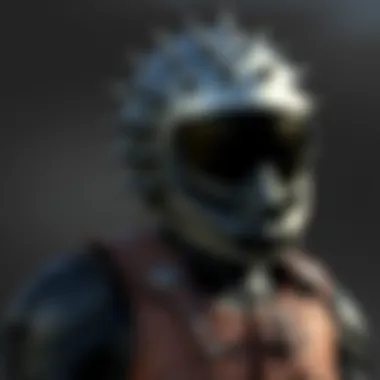Exploring the Spiked Motorcycle Helmet: History and Trends


Intro
The allure of spiked motorcycle helmets often goes beyond mere function. They encapsulate a visceral connection between man, machine, and an undying spirit of rebellion. Originating in the throes of various subcultures, these helmets serve as more than just protective gear; they stand as bold statements in the face of societal convention. This detailed examination seeks to unpack the myriad layers surrounding spiked motorcycle helmets, including their rich history, functional attributes, and cultural symbolism.
In the world of biking, aesthetics and safety might seem like two sides of the same coin, yet both play crucial roles in the popularity of spiked helmets. As the roads became a canvas for individual expression, the spike—and its overall design—grew to embody defiance, confidence, and a dash of audacity. But there’s more than meets the eye; beneath the spikes lies a wealth of knowledge concerning safety features, legal considerations, and evolving trends that ensure bikers remain protected without sacrificing style.
As we forge ahead, expect to encounter user experiences that span a spectrum, ranging from exhilarating tales of the open road to serious discussions on legal stipulations surrounding helmet use. This examination is intended for both seasoned enthusiasts and those just discovering the world of motorcycling. We aim to foster an understanding that marries the appeal of a helmet adorned with spikes with the practical concerns all riders face. Let's gear up and dive into a narrative that is both comprehensive and enriching, revealing the distinct character of the spiked motorcycle helmet.
Preface to Spiked Motorcycle Helmets
The motorcycle helmet, a crucial piece of protective gear, has undergone transformations throughout the years. Among these transformations, the emergence of spiked helmets stands out, not just for their practicality but also for their visual impact. In this section, we explore the significance of spiked motorcycle helmets, shedding light on aspects such as their definition, purpose, and cultural connotations.
Definition and Overview
A spiked motorcycle helmet is typically characterized by protruding spikes along its outer shell, lending an aggressive aesthetic to the traditional helmet design. While they fundamentally serve the same purpose as standard helmets—protecting the rider's head in case of accidents—the inclusion of spikes adds an element of expression and personalization. These helmets are often crafted from heavy-duty materials like fiberglass or polycarbonate, ensuring they meet safety standards while simultaneously making a statement.
The appeal of spiked helmets can vary amongst different motorcycle communities. From the rugged biker types to individualists looking to stand out, each group uses this helmet style to convey a particular sentiment or identity. Combine this with the raw sense of freedom that motorcycle riding invokes, and the spiked helmet becomes more than just a safety feature; it becomes an extension of the rider’s persona.
Purpose of Spikes
Diving into the question of why spikes are added to helmets is essential in understanding their role. Firstly, from a purely functional perspective, spikes can slightly enhance safety in specific scenarios. In the unfortunate event of a fall, they can possibly deflect minor abrasions. However, it's crucial to note that safety experts often advise against this as excessive protrusions might cause injuries as well.
On a broader level, the spikes embody a rebellious spirit often associated with motorcycle culture. They symbolize strength, defiance, and individuality. Bikers might perceive their choice of helmet as an assertion of their right to live freely, unbound by societal norms and expectations. As such, the spikes can signify a lifestyle—or a statement—just as much as they represent a choice in equipment. Here's a concise breakdown of the layers behind these spikes:
- Visual Aggression: The spikes create an edgy appearance, appealing to those who favor bold designs.
- Cultural Statement: They often represent a break from conformity, connecting riders to a rich history of motorcycle subcultures.
- Personal Identity: Riders frequently use such designs to reflect their tastes, values, and affiliations within the biking community.
"The spiked helmet is not just a helmet - it's a reflection of who you are, a badge of honor in the open road's deceptive embrace."
In summary, the introduction of spiked helmets redefines the traditional outlook on motorcycle safety gear. They represent a blend of personal expression, potential safety benefits, and a deep-rooted cultural significance. Nihilistic charm meets durable function, creating a helmet that is as striking as it is essential.
Historical Context
Understanding the historical context surrounding spiked motorcycle helmets is crucial as it sheds light on their role in motorcycle culture and the evolution of safety gear. The roots of these helmets are intertwined with the broader history of motorcycle riding, starting from the safety concerns in the early days of motorcycling to the expression of individuality and rebellion in contemporary culture. A helmet is not just a piece of equipment; it signifies the rider's identity and their relationship with the motorcycle. Exploring this context offers not only insights into how spiked helmets evolved but also how they resonate with subcultures and societal shifts over the decades.
Origins of Motorcycle Helmets
The first motorcycle helmets appeared around the 1910s, initially influenced by aviation helmets to provide head protection. Early helmets were made of leather and offered minimal protection, primarily serving as a barrier against the wind and debris rather than significant safety gear. As motorcycle popularity surged, so did the recognition of the need for safer options.
In the late 1930s, an interesting shift occurred when the American Motorcycle Association started advocating for helmet use. This was a response to mounting concerns over fatalities in motorcycle accidents. The original helmets, while functional, were more about basic construction than high safety standards, primarily because motorcycle safety technology was still in its infancy.
Evolution of Design
When diving into the evolution of helmet design, one can see a fascinating progression influenced by technological advances and changing legislation. By the 1950s and '60s, manufacturers began employing materials like fiberglass and expanded polystyrene, moving beyond leather to enhance impact resistance. As concerns for rider safety grew, so did the requirement for standards set by organizations such as the Department of Transportation (DOT) in the U.S.
The introduction of spikes, while often seen as a stylistic statement, actually represents a blend of function and form. These spikes were initially added for decoration, aligning with a rebellious aesthetic that reflected the motorcycle culture of the time, especially among the rock and punk scenes. Over time, this aesthetic evolved further, seeing designs that catered to individual tastes across various subcultures.
Cultural Influences
The cultural backdrop against which spiked helmets emerged is anything but simple. They are not merely fashion statements; instead, they symbolize a rich tapestry of influences from music, art, and societal attitudes. The punk rock movement of the late '70s, for instance, adopted the spiked helmet as a badge of rebellion and nonconformity. It's a clear visual representation of the biker mentality—untamed and fiercely independent.
Additionally, films and media have played a pivotal role in cementing the spiked helmet's place in popular culture. Classics like Easy Rider featured iconic looks that are still celebrated today, securing a permanent spot in the visual lexicon associated with motorcycle culture. These helmets became synonymous with freedom, adventure, and a slightly dangerous lifestyle—all elements that resonate with enthusiasts even decades later.
"A helmet is not just a piece of equipment; it signifies the rider's identity and their relationship with the motorcycle."
In summary, understanding the historical context of spiked motorcycle helmets reveals much about their function and significance. They evolved due to necessity, embraced cultural trends, and became a hallmark of motorcycle heritage. As riders continue to don them, they carry forth the legacy of those earlier days, blending history, safety, and identity into one striking accessory.
For more on the safety evolution, you may check NHTSA and for a look at cultural icons in motorcycles, Wikipedia's motorcycle page.


Design Elements
The design elements of spiked motorcycle helmets play a crucial role in both their functionality and their social implications. These elements not only affect how the helmet performs in terms of safety but also influence its aesthetic appeal, which can signify various identities within motorcycle culture. It's essential to delve into the specifics of materials, safety features, and aesthetic considerations that contribute to the overall value of these unique helmets.
Materials Used
When it comes to motorcycle helmets, the materials chosen are fundamental to their protective capabilities and overall weight. Most spiked helmets are made from high-quality thermoplastic or fiberglass, which combine strength and lightness.
- Thermoplastic: This material is often favored for its resilience and ability to absorb impact. Brands like Arai and Bell utilize such materials that meet rigorous safety standards.
- Fiberglass: Known for its lightweight attributes, fiberglass is another prime choice. It provides a robust protective layer while ensuring that the helmet does not weigh the rider down, which can contribute to fatigue during long rides.
Certain spiked helmets also integrate a shock-absorbing foam layer, enhancing their ability to protect the rider in case of an accident. Advancements in composite materials further push the envelope, allowing for helmets that are not just strong but aerodynamically efficient. Thus, selecting the right materials is indispensable for both safety and comfort, factors every rider should prioritize.
Safety Features
Safety is the absolute priority when it comes to motorcycle gear, and spiked helmets are no exception. They must meet the safety standards set forth by various organizations to ensure that they withstand extreme impact without compromising the rider's safety. Here are some prominent features to look out for:
- Impact Absorption Technologies: Modern helmets incorporate multi-density foam that can absorb different levels of impact, grounding them firmly in safety. Brands like Shoei have pushed innovation in this area, providing helmets that are engineered with safety at the forefront.
- Ventilation Systems: Effective ventilation features help manage heat and moisture inside the helmet, making riding more comfortable while also enhancing focus on the road. Proper airflow can prevent distractions that arise from overheating.
- Reflective Materials: Safety isn't just about protection during accidents; it also includes visibility. Many helmets now feature reflective strips or brighter colors to ensure that riders are seen by other motorists, especially at night or in low-light conditions.
In the end, whether it's for a casual ride or a cross-country adventure, investing in a helmet with robust safety features can mean the difference between life and death.
Aesthetic Considerations
The aesthetic appeal of spiked motorcycle helmets is a major draw for many riders. Spikes, while primarily seen as a nod to rebellious subcultures, also serve as a form of self-expression. Their design can communicate individuality and attitude, attracting a particular demographic of riders. Here are a few aesthetic components that enhance their allure:
- Color and Finish: The range of colors—from matte black to vibrant neon hues—gives riders ample options to match their motorcycle or personal style. Moreover, finishes such as gloss or flat can completely change the look of a helmet.
- Custom Modifications: Many enthusiasts elect to customize their helmets with spikes, decals, or paint jobs. These personal touches create a one-of-a-kind appearance, representing the rider's identity and journey.
- Cultural Symbols: Some helmets may feature cultural or subcultural symbols in their design—think Gothic motifs or punk elements—that resonate with specific communities. Such designs often speak volumes about the wearer’s values and affiliations in the motorcycle world.
Ultimately, while safety and functionality are paramount, the aesthetic elements of spiked helmets cater to the riders' desire for personalization and group identity within the motorcycle community.
"A helmet is more than just gear—it's an extension of who you are as a rider."
By understanding these design elements, riders can make informed choices that reflect their personal style while ensuring they adhere to safety standards.
Functional Aspects
The exploration of functional aspects is crucial in understanding the practicality of spiked motorcycle helmets. Beyond just being a visual statement, these helmets are designed to protect riders while also ensuring comfort and usability on the road. Let's break down two pivotal elements: impact resistance and weight distribution.
Impact Resistance
When it comes to safety, the impact resistance of a helmet stands paramount. Spiked motorcycle helmets are constructed using advanced materials that are engineered to absorb energy during a collision. This is no small feat; the stakes are high on the open road, and having a helmet that can withstand high impacts can literally mean the difference between life and death.
Most manufacturers incorporate materials like polycarbonate and fiberglass, blending them skillfully to achieve the right balance of sturdiness and lightness. The spikes, while aesthetically striking, must also be considered in the design. They should not compromise the integrity of the helmet, which can sometimes be a trade-off in design choices.
Key Features of Impact Resistance
- High Shock Absorption: Helmets should meet specific safety standards, such as DOT (Department of Transportation) or SNELL certification, ensuring they can handle significant impacts.
- Testing Standards: Various tests are conducted to measure how much force gets transmitted to the skull upon impact, including drop tests and penetration tests.
Cultural Significance
Delving into the cultural significance of spiked motorcycle helmets is akin to flipping through the pages of a complex history book. These helmets are not merely protective gear; they hold layers of identity, rebellion, and individualism within the motorcycle community. With roots embedded deeply in the psyche of riders, they transcend their basic functionality to become symbols of belonging and defiance.
Subcultures and Identity
Within the realm of motorcycle culture, spikes serve as a metaphoric and literal manifestation of the user's identity. The appeal of these helmets often draws enthusiasts from subcultures such as punk rock, heavy metal, and even goth. Each community finds its unique expression through the spikes, often reflective of broader societal attitudes toward freedom and authority. Riders don garments and helmets that reflect their personal narratives, embracing styles that might be considered both avant-garde and a tad rebellious. In a sense, each spike represents not just a design choice but a badge of honor for some, marking one's journey into individuality amidst a collective identity.
Take, for instance, the motorcycle rallies where these helmets often shine. The sight of a gathering filled with riders in spiked helmets offers a glimpse into a community that celebrates diversity yet finds unity in shared values. This symbol sets the stage for open conversations about personal freedoms, the aesthetic of rebellion, and a shared love of the open road. The spikes reflect more than a fashion statement; they're a nod to an ethos that champions being unapologetically oneself.
"In many ways, motorcycle helmets with spikes have the ability to fuse personal history with collective memory. Each spike tells a story, be it of adventure, loss, or triumph in the face of conformity."
Representation in Media


The presence of spiked motorcycle helmets in various media forms further deepens their cultural significance. From movies to music videos, these helmets often amplify themes of rebellion, adventure, and alternative lifestyles. Iconic films like "The Wild One" or even more contemporary series like "Sons of Anarchy" showcase the helmet as a central prop that reinforces character identity and narrative tone. Whether it's the grizzled veteran or the young rebel, the spiked helmet serves as an extension of the character's persona.
Music too has adopted the spiked helmet, particularly within genres like punk and heavy metal. Bands and their fandoms often sport these helmets, becoming a visual representation of the music's themes of dissent and nonconformity. The aesthetic is not just a trend but part of a larger commentary on society, reflecting an embrace of individuality that often stands in stark contrast to mainstream culture.
In online communities, social media platforms, and forums like Reddit, these helmets spark discussions beyond their visual appeal. Posts featuring photos and experiences often dissect their role in shaping the identity of riders and what they stand for in broader cultural conversations, especially around themes like freedom of expression and lifestyle choices. It becomes clear that spiked motorcycle helmets are as much a staple in the subcultures they represent as they are powerful symbols conveying who the riders are.
As this reciprocal relationship continues to evolve between the helmet and its wearer, one cannot ignore the significance it holds as a cultural artifact—steeped in individuality, community, and visual storytelling.
Legal Considerations
The topic of legal considerations in relation to spiked motorcycle helmets is crucial not just from a safety perspective, but also for ensuring compliance with varying state and federal laws. Understanding the intricacies of helmet laws helps motorcyclists navigate the landscape of regulations while also highlighting the societal responsibilities that come with wearing protective gear.
Helmet Laws and Regulations
Helmet laws can vary widely from one region to another. In many areas, wearing a helmet is mandatory, while some jurisdictions allow adult riders to opt out of wearing one under specific conditions. For instance, states like California and New York have stringent helmet laws requiring all riders to don approved helmets, regardless of age. In contrast, states like Illinois and Iowa have no helmet laws whatsoever, which can lead to a false sense of safety among some riders.
This discrepancy brings up essential points for spiked motorcycle helmet owners:
- Compliance: Riders must ensure their helmets meet the requirements established by state regulations. Non-compliance can lead to fines or, worse, legal action in case of an accident.
- Safety Ratings: The Department of Transportation (DOT) provides a certification that helmets must meet to be legally used. Spiked helmets, like any other, must be DOT-approved to be considered legal in regulated areas.
- Custom Modifications: Adding spikes or other modifications to helmets can make them legally questionable. If such changes compromise the helmet's structural integrity, it may no longer be valid for road use, which can risk the rider's safety.
Just like a double-edged sword, the spiked design may turn heads while also attracting scrutiny during traffic stops. Following rules can save both life and hassle.
Liability and Safety Standards
The conversation around liability is deeply tied to helmet usage. If a rider gets into an accident while wearing a spiked helmet that lacks proper certification, liability can shift dramatically. Here are some key considerations:
- Insurance Implications: Many insurance firms require proof that riders are using helmets meeting safety standards. Non-conformance can result in denied claims or reduced payouts in cases of injury.
- Legal Accountability: If it can be proven that a helmet was not compliant with safety standards during an incident, liability could fall squarely on the rider, leading to potential financial and legal consequences.
- Manufacturer Responsibility: Helmet producers must adhere to strict guidelines when creating spiked designs. Should a helmet be released without proper testing, the manufacturer may face significant repercussions in court.
Ultimately, navigating these legal waters means remaining vigilant and informed. Riders might find value in joining forums or communities to discuss common challenges related to helmet compliance and ensuring they follow the most current guidelines.
As highlighted by a report from the National Highway Traffic Safety Administration:
"Rider safety is paramount; understanding and adhering to helmet laws can drastically reduce fatalities on the road."
For those seeking more information, consider exploring resources like the NHTSA (nhtsa.gov) or motorcycle safety organizations (motorcyclistassociates.org) for guidance.
Market Trends
The world of spiked motorcycle helmets is not just a niche; it’s a ever-evolving category that reflects broader trends in both fashion and safety. Understanding these market trends is crucial for manufacturers, riders, and enthusiasts alike, as they dictate not just what’s popular but also what’s practical and safe. As riders become more discerning about both style and utility, market trends offer insight into consumer behavior and technological advancements that shape the helmet landscape.
Consumer Preferences
In recent years, there has been a noticeable shift in consumer preferences when it comes to motorcycle helmets.
- Safety Meets Style: Riders are increasingly seeking helmets that provide adequate protection without skimping on aesthetic appeal. The spiked design, once relegated to the realm of punk culture, has permeated mainstream riding communities.
- Weight Matters: Many riders prioritize lightweight options. A helmet that doesn’t weigh them down allows for extended rides without physical fatigue. Spiked helmets are now being manufactured with materials that keep them both stylish and light.
- Customization: The rise of personalization is reshaping how helmets are made and sold. Consumers want their helmets to reflect their own identities, leading brands to offer options for customizable spikes, colors, and designs.
- Sustainability Influence: More people are considering the environmental impact of their purchasing decisions. Helmets made from sustainable products are gaining traction, as eco-conscious consumers look for alternatives to traditional materials.
Additionally, user communities play a pivotal role in shaping these preferences. As riders share their experiences on platforms like Reddit or forums dedicated to motorcycle culture, trends seem to either blossom or wane based on real-world feedback from everyday users.
Innovations in the Helmet Industry
The need to stay ahead of consumer choices has propelled the helmet industry into a phase of intense innovation:
- Smart Technology: Helmets equipped with Bluetooth technology are becoming commonplace. This allows riders to connect with their smartphones for navigation, music, or communication while on the go.
- Advanced Materials: New composite materials are being tested, promising enhanced impact resistance without compromising weight. For instance, the use of aramid fibers can boost durability while maintaining comfort.
- Enhanced Ventilation: Comfort during long rides can’t be overstated. Innovations in airflow through various helmet designs are now standard, ensuring that riders can keep cool even at higher speeds.
- Unique Safety Features: Features like MIPS (Multi-directional Impact Protection System) and ECE certification testing are becoming industry standards, providing extra layers of safety that address rotational forces during an impact.
These innovations signify a broader trend towards integrating form and function, where safety doesn't have to compromise style. The spiked motorcycle helmet, once only a statement piece, is transforming into a fully competent safety device that appeals to various demographics.
"As consumer demands evolve, the motorcycle helmet industry must adapt. Failure to do so can leave brands in the rearview mirror."


User Experiences
When it comes to spiked motorcycle helmets, personal experiences can add depth to understanding their role beyond mere fashion statements. Users often share tales of their adventures—gallery of moments that showcases both the spectacle and practicality of wearing such an unusual piece of gear. These narratives significantly enrich this examination, as they reveal how the helmet resonates with the identity of the rider and their lifestyle.
Personal stories also shed light on the camaraderie formed within riding communities. The experience of a motorcycle ride rarely happens in isolation; it often involves shared adventures or brooding on high roads with friends. A rider might mention crossing nasty weather, yet coming out unscathed because of reliable headgear, spikes and all. Fellow riders tend to bond over conquerable challenges, and helmets become a topic of interest during those tales, forwarding the dialogue on safety and style.
In one vivid account from a rider who calls themselves "IronJess," they recounted their first ride through rugged terrain wearing a spiked helmet. Jess described how the helmet not only protected her from unexpected falls but drew attention from fellow bikers at a stop. In her words, "It's like wearing a badge of honor, displaying the grit that each ride demands. When someone compliments my helmet, it’s a conversation starter that quickly builds connections."
Such narratives encourage others to share their own stories, creating a tapestry that reflects the multifaceted experiences of motorcyclists. Ceratinly, these personal stories highlight emotional connections and the individual significance of helmets in shaping riding experiences.
Community Feedback
Community feedback serves as a treasure trove of insights regarding spiked motorcycle helmets, effectively bridging personal narratives with broader opinions. Various forums, including Reddit and specialized motorcycle community sites, are frequently packed with discussions and reviews regarding helmet safety, aesthetics, and practical usage.
Many riders gravitate towards platforms like Facebook Groups or Motorcycle subreddits, engaging in heated debates over the best designs, materials, and the importance of visibility on the road. A recent post noted a helmet's spikes acting almost as a "natural barrier," with users acknowledging how it could deter reckless drivers from getting too close. Such shared thoughts not only validate certain design choices but also reaffirm community values around rider safety.
Feedback often includes:
- Safety Ratings: Many users prioritize helmets that adhere to stringent safety standards, often forming discussions on models like the Bell Qualifier, which some community members have found beneficial in crashes.
- Aesthetic Appeal: Riders frequently share pictures showcasing various models, providing visual guides to what may look great on the road.
- Durability: Insights on weather resistance or components resisting wear and tear after lengthy rides are frequently discussed.
"When a helmet can spark a conversation not just about style but also about safety, it resonates with our experience over the years." - Motorcyclist on Reddit.
By aggregating these reflections, one can appreciate how spiked helmets transcend being mere accessories; they cultivate an ethos grounded in resilience and boldness. Whether it’s feedback from seasoned riders or novices just hitting the highway, every opinion adds a crucial layer to understanding the full impact of these helmets.
Safety Advancements
Importance of Safety Advancements
In the realm of motorcycle helmets, particularly spiked designs, safety advancements play a pivotal role. As riding continues to be a popular form of transport and leisure, ensuring riders are protected against potential hazards is paramount. The evolving technology in helmet design has led to the development of features that not only enhance safety but also improve comfort and utility.
When riders don helmets equipped with the latest safety advancements, they are investing in more than just headgear; they are safeguarding their lives. Helmet safety standards have become stricter over the years, urging manufacturers to innovate. These changes are imperative, considering that the incidence of motorcycle accidents continues to pose a significant threat.
Riders equipped with technologically advanced helmets report enhanced confidence on the road, knowing they have reliable protection against impacts. Safety advancements also address secondary concerns, such as visibility and communication, which can greatly affect a rider's awareness and reaction time.
Technological Innovations
A notable area where technology has flourished is in the materials used in the construction of spiked motorcycle helmets. Modern helmets may incorporate materials such as carbon fiber or advanced polymers, which provide superior impact resistance while keeping the weight down. This lightness reduces neck strain during long rides, making it a crucial aspect to consider.
Further, some helmets now feature integrated smart technology, such as Bluetooth connectivity for hands-free communication and GPS navigation. This integration allows riders to stay informed about directions and traffic alerts without compromising their focus on the road. Such innovations elevate the practicality of helmets, making them essential tools for motorcyclists.
In addition to that, ventilation systems have been optimized. Riders experience a significant reduction in heat buildup, thanks to advanced airflow designs. This is crucial in maintaining comfort during extended journeys, allowing riders to keep their cool both literally and figuratively.
Field Testing
The effectiveness of safety advancements is not merely theoretical; it is rooted in rigorous field testing. This process involves real-world evaluations where helmets are put through various scenarios, ensuring they can withstand the varying dynamics of motorcycle riding. Riders, especially within subcultures such as stunt biking or long-distance touring, provide feedback on these helmets under extreme conditions.
Testing includes checking for impact absorption, durability during crashes, and even assessing how the helmet behaves in adverse weather. For instance, a helmet that excels in sunny conditions might falter under heavy rain or snow. Field testing ensures that manufacturers receive authentic feedback, crucial for the continuous improvement of helmet designs.
Finale
The exploration of spiked motorcycle helmets has yielded not just insights into their design, but a deeper understanding of their role across various dimensions of motorcycle culture. These helmets serve as a fusion of safety, individuality, and community identity. As discussed, each aspect covered— from their history to user experiences—has painted a picture of what these helmets represent in a world where motorcycle riding transcends mere transportation.
Synthesizing Key Insights
- Historical Significance: Spiked motorcycle helmets are rooted in a rich history that reflects the evolution of motorcycle culture. Understanding their origins sheds light on how aesthetic choices have been influenced by shifting subcultures.
- Functional Importance: Beyond their striking appearance, these helmets are engineered to provide protection. The materials used, combined with state-of-the-art safety features, ensure they meet rigorous safety standards.
- Cultural Impact: These helmets aren't just protective gear; they resonate with a sense of belonging and identity for many riders. They symbolize rebellion and freedom, which is integral to biker heritage.
- Current Trends: The market shows a growing preference for helmets that merge safety with style. Technological innovations are paving the way for designs that take into account user feedback, influencing future helmet iterations.
It is clear that spiked motorcycle helmets have carved out a niche that merges function with fashion, appealing to both the practical and the expressive qualities of riders.
Future Directions
As we look ahead, several trends emerge that indicate how spiked motorcycle helmets may evolve:
- Enhanced Safety Features: Future designs might integrate smart technology, like built-in Bluetooth systems or impact sensors that analyze crash data in real time.
- Sustainable Materials: With increasing environmental awareness, the helm of production might shift towards more sustainable materials without compromising safety.
- Customization: The demand for personalized gear is on the rise. Future helmets may offer more customization options, allowing riders to showcase their individual personality through unique designs and color schemes.
- Broader Acceptance: Efforts to educate riders on the safety and utility of these helmets could lead to broader acceptance in regions where they are currently frowned upon as unconventional.
As motorcycle culture evolves, so too will the spiked helmets that symbolize its spirit. The ongoing dialogue around safety, aesthetics, and personal expression will inform future developments, ensuring that these helmets remain relevant to both enthusiasts and newcomers.







